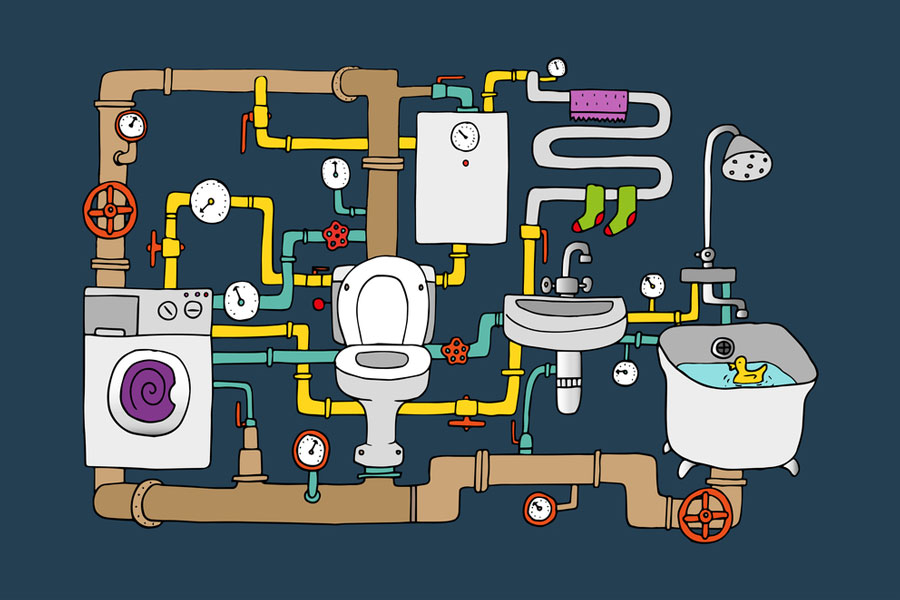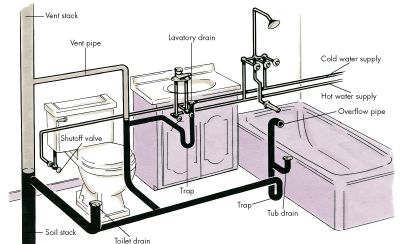The Design of Your Home's Plumbing System Explained
Click HereWe have stumbled on the article relating to Understanding Your Home's Plumbing Anatomy down the page on the internet and reckoned it made good sense to quickly share it with you on this page.

Understanding how your home's plumbing system functions is crucial for every single property owner. From providing tidy water for alcohol consumption, food preparation, and bathing to securely getting rid of wastewater, a well-maintained plumbing system is important for your family members's health and convenience. In this detailed overview, we'll explore the elaborate network that comprises your home's pipes and deal tips on maintenance, upgrades, and handling common issues.
Introduction
Your home's pipes system is greater than just a network of pipes; it's a complicated system that guarantees you have accessibility to tidy water and efficient wastewater removal. Understanding its elements and exactly how they collaborate can assist you stop pricey repairs and ensure whatever runs efficiently.
Fundamental Elements of a Pipes System
Pipelines and Tubes
At the heart of your plumbing system are the pipes and tubing that carry water throughout your home. These can be made from different materials such as copper, PVC, or PEX, each with its benefits in regards to longevity and cost-effectiveness.
Components: Sinks, Toilets, Showers, and so on.
Components like sinks, bathrooms, showers, and bath tubs are where water is made use of in your house. Recognizing just how these components attach to the pipes system aids in detecting troubles and intending upgrades.
Valves and Shut-off Points
Valves manage the flow of water in your plumbing system. Shut-off valves are essential throughout emergency situations or when you require to make fixings, permitting you to separate parts of the system without disrupting water flow to the entire residence.
Water System
Key Water Line
The major water line attaches your home to the local water system or a personal well. It's where water enters your home and is distributed to numerous components.
Water Meter and Stress Regulatory Authority
The water meter steps your water usage, while a pressure regulatory authority makes certain that water moves at a risk-free pressure throughout your home's pipes system, stopping damage to pipes and components.
Cold Water vs. Warm water Lines
Comprehending the distinction between cold water lines, which provide water directly from the main, and warm water lines, which bring heated water from the water heater, aids in fixing and planning for upgrades.
Drainage System
Drain Pipes Water Lines and Traps
Drain pipes carry wastewater far from sinks, showers, and bathrooms to the sewer or septic system. Catches protect against sewage system gases from entering your home and additionally catch debris that might cause clogs.
Air flow Pipelines
Air flow pipelines enable air into the drainage system, preventing suction that can reduce drain and trigger traps to empty. Correct air flow is necessary for preserving the integrity of your plumbing system.
Relevance of Correct Drain
Guaranteeing proper water drainage protects against back-ups and water damage. Routinely cleaning drains and preserving traps can stop costly fixings and extend the life of your pipes system.
Water Heating Unit
Sorts Of Water Heaters
Hot water heater can be tankless or conventional tank-style. Tankless heating systems warm water as needed, while tanks save warmed water for immediate usage.
How Water Heaters Link to the Pipes System
Understanding exactly how hot water heater connect to both the cold water supply and warm water distribution lines aids in identifying concerns like insufficient warm water or leakages.
Maintenance Tips for Water Heaters
On a regular basis purging your water heater to eliminate debris, checking the temperature level setups, and examining for leakages can expand its life expectancy and boost energy effectiveness.
Typical Pipes Issues
Leakages and Their Reasons
Leaks can happen because of maturing pipes, loose installations, or high water stress. Addressing leakages without delay prevents water damage and mold development.
Obstructions and Blockages
Blockages in drains pipes and commodes are often triggered by purging non-flushable things or a buildup of grease and hair. Utilizing drainpipe displays and being mindful of what drops your drains pipes can prevent clogs.
Indications of Pipes Troubles to Expect
Low tide pressure, slow drains, foul odors, or uncommonly high water expenses are indicators of possible pipes problems that should be resolved promptly.
Plumbing Maintenance Tips
Regular Evaluations and Checks
Arrange annual pipes assessments to catch problems early. Search for indications of leakages, rust, or mineral accumulation in taps and showerheads.
Do It Yourself Upkeep Tasks
Basic tasks like cleaning faucet aerators, checking for toilet leaks using dye tablets, or insulating revealed pipelines in cool environments can stop major plumbing issues.
When to Call an Expert Plumbing Professional
Know when a plumbing issue requires expert know-how. Trying complicated repair services without correct expertise can lead to more damage and higher repair work expenses.
Upgrading Your Plumbing System
Reasons for Upgrading
Upgrading to water-efficient fixtures or replacing old pipes can enhance water high quality, minimize water expenses, and boost the worth of your home.
Modern Pipes Technologies and Their Advantages
Discover modern technologies like clever leakage detectors, water-saving commodes, and energy-efficient hot water heater that can conserve money and reduce environmental impact.
Cost Factors To Consider and ROI
Compute the ahead of time prices versus lasting financial savings when taking into consideration pipes upgrades. Lots of upgrades pay for themselves with decreased utility costs and fewer repairs.
Ecological Effect and Conservation
Water-Saving Components and Home Appliances
Installing low-flow faucets, showerheads, and commodes can considerably reduce water use without giving up efficiency.
Tips for Reducing Water Use
Easy habits like taking care of leaks without delay, taking shorter showers, and running full tons of laundry and recipes can conserve water and reduced your energy costs.
Eco-Friendly Plumbing Options
Consider lasting pipes materials like bamboo for flooring, which is durable and green, or recycled glass for kitchen counters.
Emergency Preparedness
Actions to Take During a Plumbing Emergency situation
Know where your shut-off valves are located and just how to shut off the supply of water in case of a ruptured pipeline or major leakage.
Value of Having Emergency Calls Helpful
Keep call info for local plumbing professionals or emergency solutions easily available for fast response during a pipes crisis.
Do It Yourself Emergency Situation Fixes (When Appropriate).
Short-lived fixes like utilizing air duct tape to patch a leaking pipeline or placing a container under a trickling faucet can reduce damages until an expert plumbing gets here.
Conclusion.
Comprehending the composition of your home's pipes system empowers you to preserve it successfully, conserving time and money on repair services. By adhering to normal maintenance routines and remaining educated regarding modern-day plumbing technologies, you can ensure your pipes system runs successfully for years to find.
Exploring Your Homes Plumbing Anatomy
Water Supply System
Main Water Line: This is where water enters your home from the municipal supply or a private well.
Water Meter: Typically located near where the main water line enters the property, it measures the amount of water used.
Shutoff Valve: It s crucial to know where this is in case of emergencies. It allows you to turn off the water supply to the entire house.
Pipes and Fittings: These distribute water throughout your home. Materials can include copper, PVC, or PEX.
Drain-Waste-Vent (DWV) System
Drains: Located in sinks, showers, and tubs, these carry wastewater away.
Traps: U-shaped pipes under sinks that hold standing water, blocking sewer gases from entering the home.
Vents: Pipes that lead from the DWV system to the outside, preventing vacuum formation and allowing gases to escape.
Sewer Line: Carries all wastewater from the home to the municipal sewer system or a septic tank.
Fixtures and Appliances
Sinks, Toilets, and Showers
Dishwashers and Washing Machines
Water Heaters
Maintenance Tips
Regularly check for leaks in exposed pipes and around fixtures.
Inspect the water heater annually for signs of wear.
Clean drains and traps to prevent clogs and odors.
Know how to shut off water to individual fixtures.
When to Call a Professional
Major leaks or burst pipes
Installation of new pipes or fixtures
Septic tank issues
Remodeling projects that involve plumbing changes
Conclusion
Understanding the anatomy of your home's plumbing is key to maintaining a functional and efficient system. Regular checks and knowing when to call in the experts can save you time, money, and stress.
https://www.mavyn.com/blog/exploring-your-homes-plumbing-anatomy

Exploring Your Homes Plumbing Anatomy
Water Supply System
Drain-Waste-Vent (DWV) System
Fixtures and Appliances
Maintenance Tips
When to Call a Professional
Conclusion
Understanding the anatomy of your home's plumbing is key to maintaining a functional and efficient system. Regular checks and knowing when to call in the experts can save you time, money, and stress.
https://www.mavyn.com/blog/exploring-your-homes-plumbing-anatomy
I am very excited about Exploring Your Homes Plumbing Anatomy and I am assuming you appreciated the blog posting. Enjoyed reading our content? Please share it. Let other people locate it. We truly appreciate your readership.
Browse Website